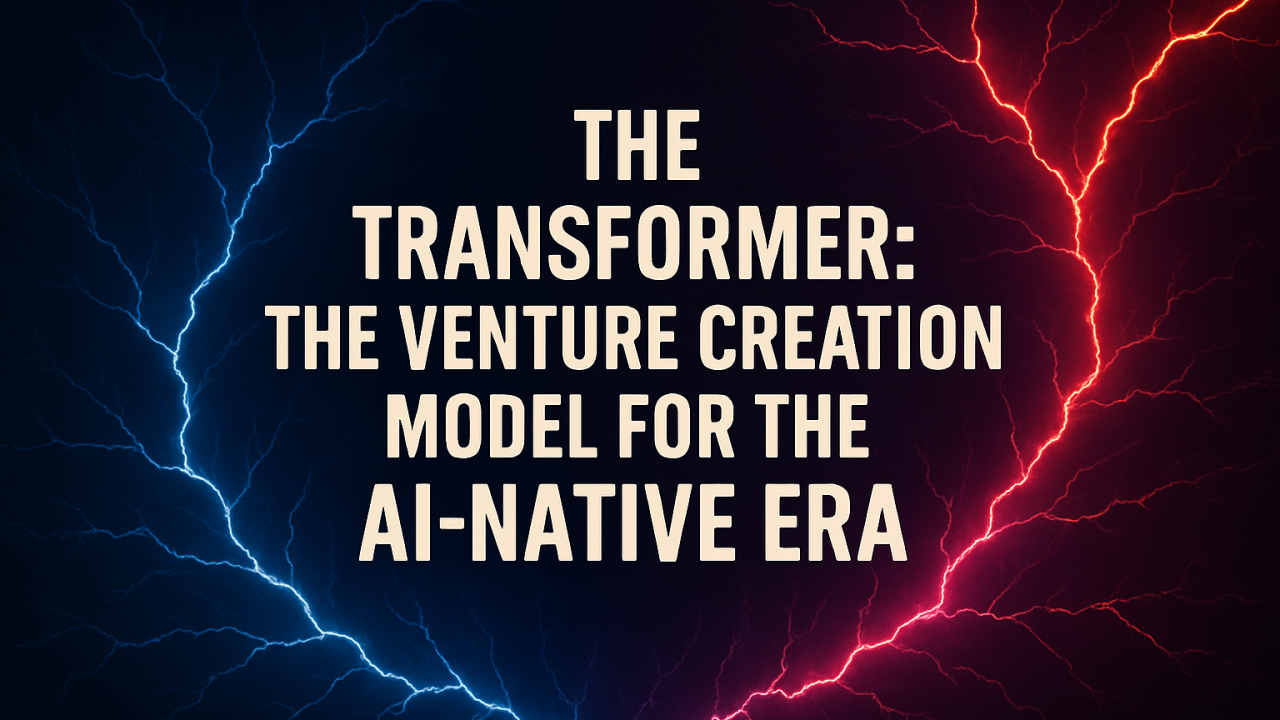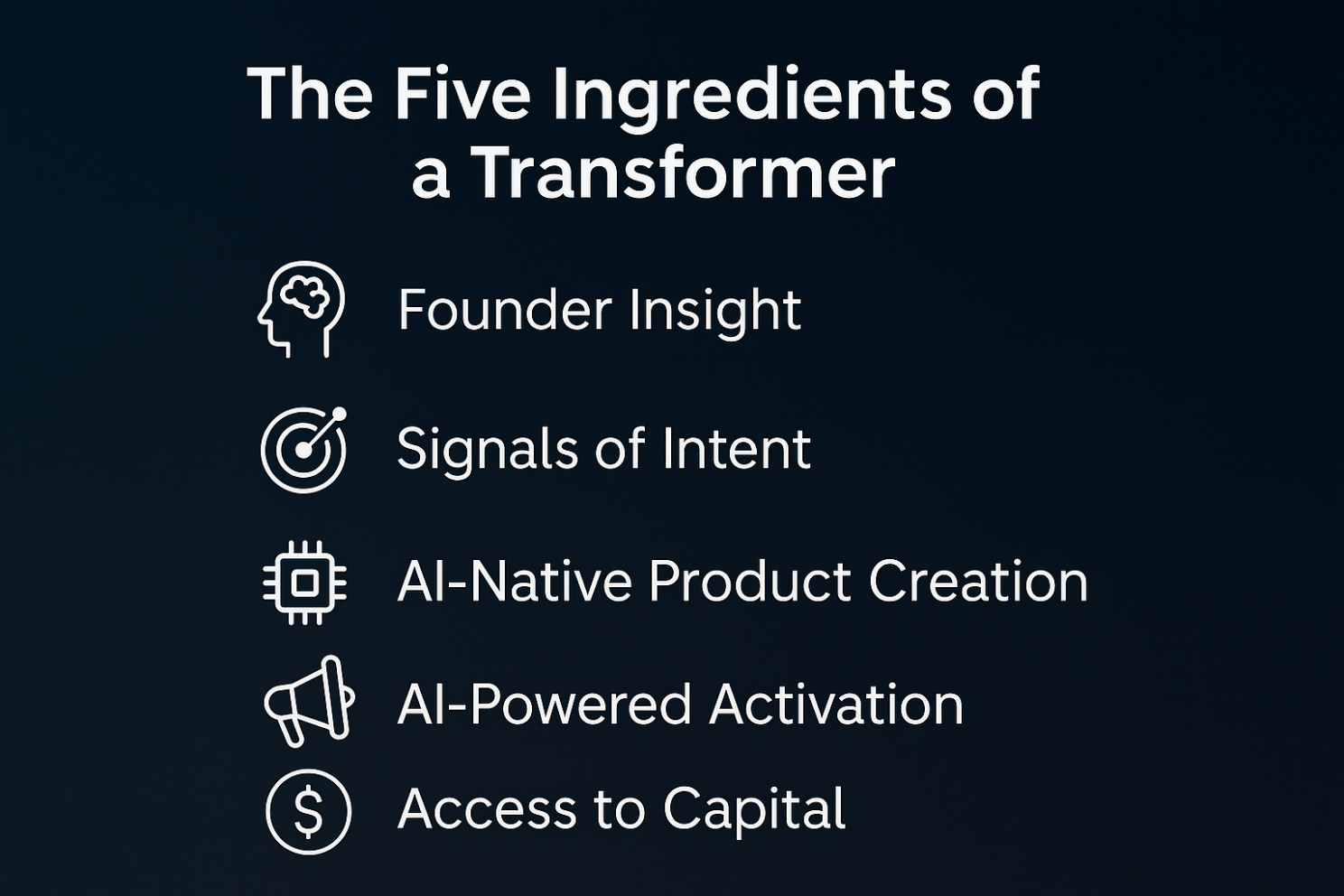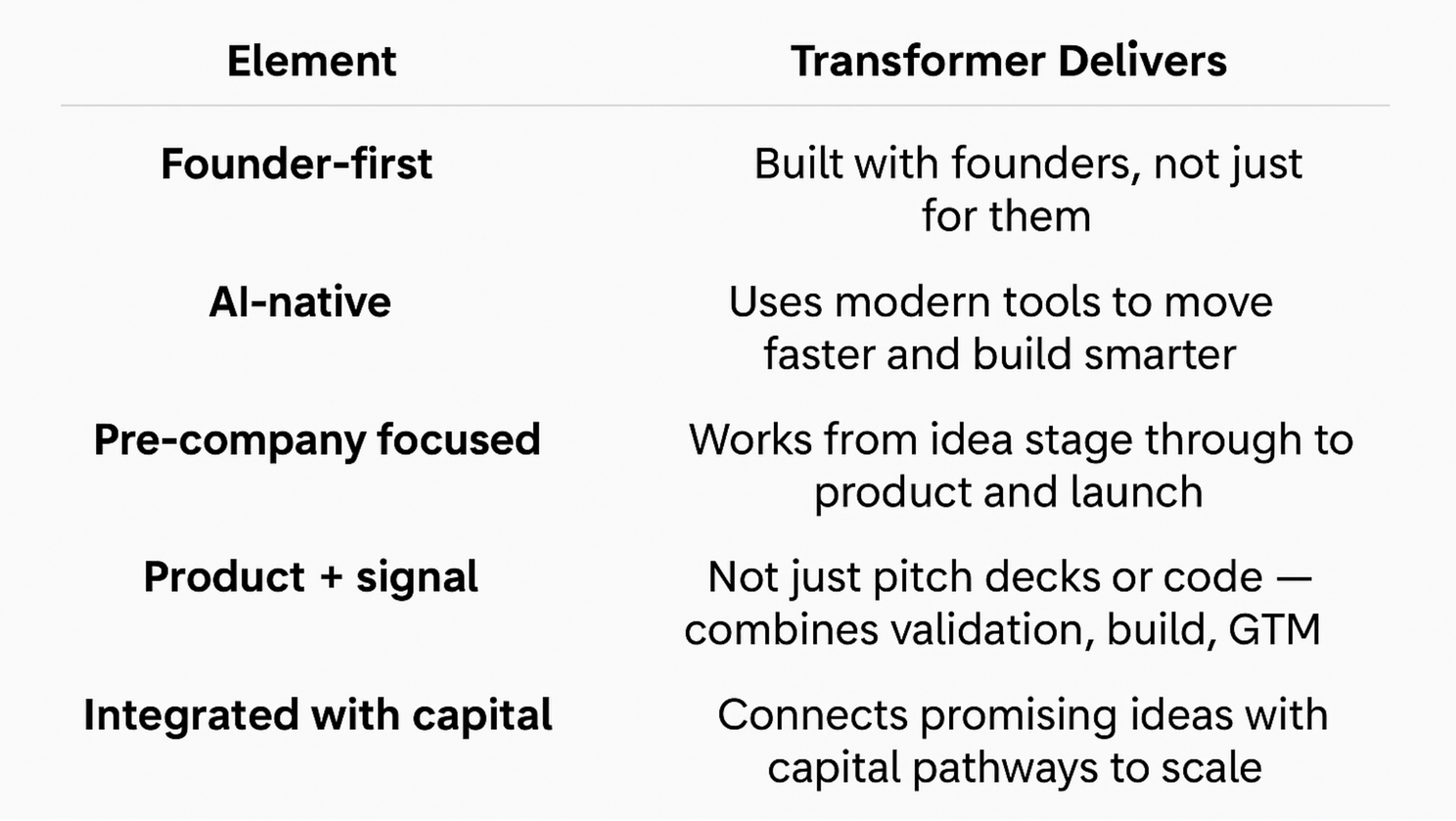
Introducing the Transformer: A new model for building Startups in 2025
A New Chapter in Venture Creation
We've seen this moment before. In 2005, Y Combinator redefined the early-stage landscape by formalising the accelerator. In the years that followed, venture studios emerged as operational engines for startup creation, pairing capital with build teams inside closed ecosystems. Each wave reshaped how new companies came to life.
Today, we stand at the edge of another shift, one driven not just by capital or community, but by capability.
AI has changed the cost, speed, and structure of building. Founders no longer need to raise a round to test an idea, or wait months to ship a product. But what they do need, more than ever, is clarity, structure, and signal. They need a path from insight to something real. And they need it fast.
The next model of venture creation isn't just about acceleration or access. It's about transformation, taking insight and turning it into something that lives. From friction to flow. From idea to product. From story to signal.
You've seen it already, founders going from prototype to launch over a weekend, investors chasing signal from a Notion doc and a voiceover. This isn't the future. This is the present.
Most existing models weren't built for this reality. They were designed for an earlier era of software, before no-code, before large language models, before AI tooling made it possible to go from sketch to product in days, not quarters.
That's why a new category is emerging. Not as a replacement for what came before, but as a response to what's now possible.
We call it the Transformer.
The Current Paradigm
Founders today often move through a sequence of startup programmes, starting with incubators, which provide early-stage guidance, community, and space to explore an idea in its earliest form. If the idea shows promise, they might join an accelerator, where they receive mentorship, funding, and support to refine their pitch, grow their traction, and raise capital.
Some founders may also plug into a venture studio, which builds companies internally and installs teams to take them forward, though this typically excludes external founders or early-stage concepts. In some cases, founders turn to dev shops to get something built, but those are transactional and rarely strategic.
Each of these models has played a valuable role in shaping the startup ecosystem:
- •Incubators: created space for imagination and exploration.
- •Accelerators: introduced urgency, visibility, and network.
- •Studios: professionalised the build process, adding operational depth.
- •Dev shops: opened access to development talent.
But they were all built for a different time, when code was expensive, teams were co-located, and traction was something you earned over quarters, not days.
In an AI-native era, the boundaries between idea, product, and signal are collapsing. Founders don't just need advice or intros, they need outcomes. They need to make progress before the traditional models can engage.
That's where a new category, the Transformer comes in.
Introducing the Transformer
Born from the gaps between incubators, accelerators, studios, and dev shops but designed for a different era — is a new category: the Transformer.
A Transformer is not a format or a stage. It's a new class of venture creation built for the realities of modern entrepreneurship, where speed, clarity, and traction matter more than ever, and where AI tools unlock entirely new ways to build.
Transformers work at the earliest moment, often before a company exists, helping founders move from concept to investable product with structure, creativity, and velocity.
A Transformer is not a platform or a playbook. It integrates capital, product, go-to-market, and validation into one high-leverage structure. It sits between capital and code, combining both to create what didn't exist before.
What defines a Transformer isn't its timeline or team structure, but its ingredients. A Transformer integrates five core components into a single, high-leverage creation flow:
🧹 The Five Ingredients of a Transformer
1. Founder Insight
A sharp, lived perspective on a problem or opportunity, whether from experience, domain expertise, or pure observation.
2. Signals of Intent
Early evidence that the problem is real: users searching, engaging, struggling or otherwise showing up with unmet need.
3. AI-Native Product Creation
A working proof-of-concept or MVP built using the latest AI tools and reusable components — fast, modular, and scalable.
4. AI-Powered Activation
Launch strategies powered by AI: smart content generation, automated GTM testing, rapid iteration, and early traction loops.
5. Access to Capital
A clear path to funding, often through embedded investment or tightly aligned investor networks, so validated ideas don't stall.

This is not pitch prep. It's not code for hire. It's a structured process that turns a raw idea into a living, investable company — in weeks, not months.
That's why we call it a Transformer. Because it doesn't just support or accelerate, it transforms. An idea becomes a product. A product becomes a company. And a founder goes from asking "what if?" to building "what is."
Who Is the Transformer Model For?
Transformers support a wide range of founders, each with different strengths, but a shared urgency to build:
AI-native (Vibe) founders
Get more than a technical playground. They gain clarity, feedback loops, and strategic guardrails. In an era of "vibe coding," Transformers help shape chaos into scalable systems, turning momentum into meaningful output.
Non-technical or commercial founders
Gain a path from idea to execution without having to recruit and manage a build team. With access to professional engineers and AI-native tools, they can go from insight to MVP in weeks, not quarters.
Operator-founders and domain experts
Benefit from structured validation and smart GTM activation, helping them pressure-test their ideas, shape early traction, and build real signal.
Startups begin with uncertainty. What founders need isn't just guidance or tooling, they need belief, direction, and the ability to move. That's what a Transformer delivers.
No matter where a founder starts, with code, with insight, or with conviction, a Transformer helps them build the thing that makes the pitch real.

Transformers don't compete with accelerators — they prepare founders to thrive in them.
Why Now: The AI-Native Shift
Until recently, turning an idea into a company was slow, expensive, and uncertain. Founders needed to assemble teams, raise money, and commit months of effort, often before having real proof that they were solving the right problem.
But something fundamental has shifted.
The rise of AI tools, from code generation and design to testing, content creation, and go-to-market, has compressed what used to take months into weeks, or even days. The distance between idea and execution is collapsing.
Now, a lean, focused team can collaborate with a founder to:
- •Validate a problem
- •Build a functional product
- •Launch with narrative and traction
- •And do it before traditional funding or team formation begins
This isn't just about speed. It's about leverage. The AI-native era allows founders to make meaningful progress with smaller teams, lower capital requirements, and smarter systems. It changes what's possible and in doing so, it demands a new creation model.
That model is the Transformer.
Where older models required traction to begin, Transformers generate traction. Where dev shops deliver outputs, Transformers shape outcomes. Where accelerators reward pitch decks, Transformers help build what the pitch should be about in the first place.
We're not in the old startup economy anymore. This is something else.
The Transformer exists because AI makes a new kind of venture creation possible, and necessary.
The New Founder Journey
A Transformer doesn't just fill a gap in the startup ecosystem, it reframes the early-stage journey itself.
Here's how the path shifts when a Transformer is involved:
The Typical Founder Journey (Including Transformer)
Incubator – Explore your idea, meet peers, find early guidance
→ Transformer ← – Validate your idea, build the product, launch with signal
Accelerator – Scale traction, refine your pitch, raise capital
VC / Seed Fund – Raise institutional funding and build your team
Studio – Join or spin out a venture if deeply aligned
Dev Shop – Used tactically for additional support
What Makes a Transformer Different

The result is a startup that's not just investable, but ready, with clarity of purpose, early evidence of traction, and a product that lives in the hands of real users.
The Age of Transformation
A Transformer is the forge where ideas become products, products become companies, and founders step into momentum.
This isn't just a new label. It's a new logic. A model built for the era we're already living in, where speed matters, clarity is currency, and AI changes everything.
The startup playbook has changed. What comes next isn't an accelerator. It's not a studio. It's not a dev shop.
It's a Transformer, and it's the future of how startups get made.
We're not waiting for someone else to define it. This summer, we launch the first Transformer programme.
Not as an experiment — but as a new standard.
We stand at the edge of another shift, one driven not just by capital or community, but by capability. The age of transformation has already begun.
Pioneering what's next. Together.
Ready to Transform Your Startup Idea?
Learn how MOHARA can help you build and launch your startup with our Transformer approach.
Get in touch